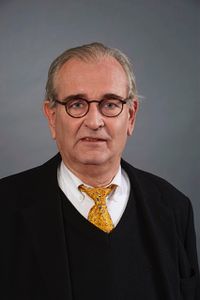(Created page with "<!-- MFI 2016 PLENARY TALKS --> {| id="mp-upper" style="width: 100%; margin:4px 0 0 0; background:none; border-spacing: 0px;" <!-- MFI 2016 PLENARY TALKS...") |
|||
| Line 11: | Line 11: | ||
* [[Plenary_speakers#speaker1| Tuesday, September 20: Rüdiger Dillmann (KIT Karlsruhe Institute of Technology, Karlsruhe, Germany)]] | * [[Plenary_speakers#speaker1| Tuesday, September 20: Rüdiger Dillmann (KIT Karlsruhe Institute of Technology, Karlsruhe, Germany)]] | ||
| − | + | * Wednesday, September 21: TBA | |
| Line 24: | Line 24: | ||
| class="MainPageBG" style="width:100%; border:1px solid #f2ea7e; background:#ffffe8; vertical-align:top; color:#000;" | | | class="MainPageBG" style="width:100%; border:1px solid #f2ea7e; background:#ffffe8; vertical-align:top; color:#000;" | | ||
{| id="mp-left" style="width:100%; vertical-align:top; background:#ffffe8;" | {| id="mp-left" style="width:100%; vertical-align:top; background:#ffffe8;" | ||
| − | | style="padding:2px;" | <h2 id="mp-tfa-h2" style="margin:3px; background:#fff7bd; font-family:inherit; font-size:120%; font-weight:bold; border:1px solid #f2ea7e; text-align:left; color:#000; padding:0.2em 0.4em;">Tuesday, September 20</h2> | + | | style="padding:2px;" | <h2 id="mp-tfa-h2" style="margin:3px; background:#fff7bd; font-family:inherit; font-size:120%; font-weight:bold; border:1px solid #f2ea7e; text-align:left; color:#000; padding:0.2em 0.4em;">Tuesday, September 20, 09:00 – 10:00</h2> |
|- | |- | ||
| style="color:#000;" | <div id="mp-tfa" style="padding:2px 5px"> | | style="color:#000;" | <div id="mp-tfa" style="padding:2px 5px"> | ||
<div id="speaker1"> | <div id="speaker1"> | ||
| − | === <div align="center">Rüdiger Dillmann KIT Karlsruhe Institute of Technology, Karlsruhe, Germany</div> === | + | === <div align="center">Rüdiger Dillmann, KIT Karlsruhe Institute of Technology, Karlsruhe, Germany</div> === |
==== <div align="center">Neurorobotics in the Human Brain Project: Robot Sensor-Motor Controls Based on Spiking Neural Clouds</div> ==== | ==== <div align="center">Neurorobotics in the Human Brain Project: Robot Sensor-Motor Controls Based on Spiking Neural Clouds</div> ==== | ||
</div> | </div> | ||
Revision as of 10:05, 8 August 2016
|
|


